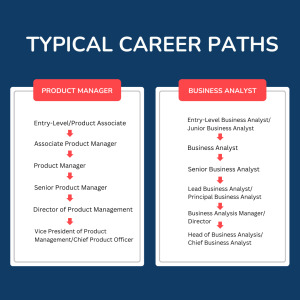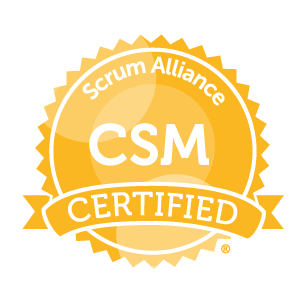So, If you’ve found your way to this blog post, chances are, like many, you’re also uncertain about the differences between a business analyst and a product manager. You might wonder what these roles are, which career path is superior, and how they collaborate on projects. Well, you’re in luck because this is precisely where you’ll discover all the answers to these questions.
As a company advances in the development of complex products, it defines positions such as product managers and business analysts. While these experts often team up on projects, their unique responsibilities set them apart, which puzzles many. Before the comparison begins, let’s understand what each role is all about.
What is a Product Manager?
Product management involves strategically directing and overseeing all aspects of a company’s product lifecycle. This includes guiding the development process, orchestrating the product’s launch into the market, and continuously improving and supporting it throughout its lifespan.
The product manager is the individual responsible for ensuring the success of a product. Their primary focus is on the product itself. They oversee the product from inception, intending to satisfy customer and company requirements. This role is crucial in any company that manufactures or sells products, as the product manager is accountable for its delivery and must possess a diverse skill set to excel. They stay updated on business and consumer trends and behaviors that directly or indirectly impact the product or company. Their responsibilities revolve around ensuring the success of a product, service, or product line, thereby contributing significantly to the broader success of the company or brand.
What is a Business Analyst?
Business analysis involves a systematic and organized approach to examining a business procedure, identifying areas for enhancement, and implementing adjustments to improve the business’s ability to meet its objectives. This process relies on facts, numerical data, and careful observations.
Business analysts play a crucial role in helping companies improve their operations, products, services, and software by analyzing data. They work within a company to optimize its processes and coordinate activities across various departments. Working closely with business leaders and users, they aim to understand how making data-driven adjustments to processes, products, services, software, and hardware can enhance efficiencies and create value. Their responsibilities include ensuring quality, gathering requirements, documenting processes, and supporting clients. Business analysts may also focus on increasing sales by engaging with potential customers, assisting with customer service, and managing accounts.
Key Differences between a Business Analyst and a Product Manager
Although Business Analysts and Product Managers share various responsibilities, their roles are far from identical. Here, we’ll explore the key differences to understand their unique contributions to product development better.
Outward vs Inward Focus: Product Managers direct their attention outward. They analyze the market and engage with customers to identify product opportunities. Their primary objective is the success of the product itself.
On the other hand, Business Analysts have an inward focus. They concentrate their efforts within the company, evaluating processes, internal systems, and practices to determine the most effective approach for building and supporting the products requested by Product Managers on behalf of customers and the market.
Business Requirements vs. Technical Specifications: The Product Manager’s role is to identify the most valuable problems to solve and ensure that the team delivers on them. They prioritize creating meaningful solutions and take ownership of the product vision and roadmap throughout its lifespan. They focus on determining what comes next for the product, its direction, customer demands, alignment with strategic goals, and the current feature development.
On the other hand, Business Analysts are tasked with gathering technical specifications to guide product development. While Product Managers focus on the “why” of the solution, Business Analysts delve into the details from a functional user perspective. They tackle questions about internal challenges, technical limitations, documentation for the team, known risks, and action items for feasible solutions.
Roles and Responsibilities of a Product Manager
Product Managers have varied responsibilities, including:
- Defining the product vision and ensuring its alignment with the overall company vision.
- Analyzing projects for costs, labor, materials, and scope.
- Consulting with end-users to identify their needs.
- Overseeing each stage of product development.
- Collaborating with production and development teams, facilitating communication with management.
- Making the product concept understandable for developers, ensuring all end-user needs are met.
- Creating a product strategy and implementing customer ideas into the product roadmap.
- Analyzing potential risks and reporting them to management, implementing safeguards, or managing risks during development.
- Working with engineers to build the product.
- Motivating the team to complete the project on time and organizing team members and resources.
- Managing the launch and post-launch stages, identifying any issues, and conducting iterations as needed.
- Communicating with stakeholders about their product expectations.
- Aligning cross-functional teams and prioritizing features.
- Mentoring associates.
- Reviewing the product backlog before meetings, ensuring requirements prioritization and feedback integration align with discussions.
- Analyzing market trends, competitor data, user behavior, and mentality to identify products with the most potential.
Roles and Responsibilities of a Business Analyst
The duties of a business analyst can vary depending on the organization but generally involve the following:
- Analyzing business opportunities for financial viability.
- Researching marketing prospects to identify expansion opportunities.
- Assisting in designing and adapting products to meet customer needs.
- Compiling and analyzing essential business data, such as customer feedback and financial reports.
- Developing solutions to meet organizational business needs.
- Supporting product managers with analysis and scoping activities.
- Assisting in the implementation of new processes.
- Advising on cost reduction strategies.
- Documenting business processes for stakeholder understanding.
- Testing new IT systems before implementation.
- Creating detailed business analyses outlining problems and solutions.
- Budgeting, predictions, planning, and tracking.
- Reporting business requirements to stakeholders.
- Recording product specifications.
- Improving and condensing processes.
How do both professionals collaborate in a company?
Product management and business analysis are distinct yet interconnected roles crucial for the success of any product or service. The collaboration and coordination of these two functions is extremely important.
Initially, the Product Manager conceptualizes solutions or ideas for new products or improvements based on a thorough analysis of customer needs and market trends. Subsequently, the Business Analyst conducts research and utilizes statistical and documentation expertise to execute the solution, collaborating with business and technical teams. While the Product Manager owns the ideation process, the Business Analyst oversees the implementation, ensuring alignment among all stakeholders. Collaboration between Business Analysts and Product Managers is pivotal in identifying optimal project solutions for the company.
Product managers and business analysts often share overlapping responsibilities in several areas:
- Defining the product vision and strategy: While product managers primarily define the overall vision and strategy, business analysts contribute by providing market insights and customer needs analysis.
- Requirements gathering and analysis: Both roles are involved in gathering and analyzing requirements, with business analysts leading detailed business needs analysis and product managers providing input on the strategic direction aligning objectives with the organization’s vision.
- Collaboration with cross-functional teams: Business analysts and product managers collaborate closely with cross-functional teams to guarantee that the product satisfies both business requirements and market demands.
- Evaluating and measuring product success: Product managers, business analysts, and project managers may all participate in evaluating product success by analyzing metrics like user engagement and revenue.
- Stakeholder communication: Both roles regularly communicate and engage with stakeholders to consider their perspectives and expectations.
- Risk management: Business analysts and project managers collaborate to assess potential obstacles and develop contingency plans.
- Quality assurance: They work together to establish and assess quality standards, ensuring high-quality project deliverables and promoting a culture of excellence within the team.
Career Path for Product Managers and Business Analysts

Product Management is experiencing remarkable growth and is expected to surge in demand in the coming years. According to the US Bureau of Labor Statistics, job growth in this field is projected to increase by 6 percent from 2022 to 2032, which is faster than the average for all occupations. According to Glassdoor data, the average salary for a Product Manager is $156,972 per year in the United States. Depending on your unique interests, skills, and background, you can go beyond the typical product manager career path, such as strategic project management consultant, portfolio manager, data science/product analytics, etc.
Business analysts, too, are in high demand due to organizations’ growing dependence on data for critical decision-making. As per the Bureau of Labor Statistics (BLS), there is an anticipated 11% growth in the demand for management analysts from 2021 to 2031, surpassing the average rate of growth across all occupations. According to Glassdoor, the average salary for a Business Analyst is $93,508 per year in the United States. While the career path of a Business Analyst follows a trajectory of increasing responsibilities and expertise, you can also explore other opportunities for professional growth and specialization, including Data Analyst/Scientist, Product Manager, Domain Specialist, and more.
Product Manager Courses
As the pace of change in the business world accelerates, Agile product management approaches are becoming increasingly prevalent. This trend necessitates faster and more cost-effective product release. Employers now prioritize relevant qualifications and certifications when hiring product management staff. Therefore, product managers must explore specialized courses to enhance their ability to lead successful products and contribute to organizational success. Some courses worth considering include:
- Certified ScrumMaster® (CSM®)
- Certified Scrum Product Owner® (CSPO®)
- SAFe® Product Owner/Product Manager (POPM®)
- Leading SAFe®
- SAFe®Agile Product Management
- Agile Certified Practitioner (PMI-ACP)
- ICAgile Certified Professional – Agile Certified Coaching (ICP-ACC)
Business Analyst Courses
According to IIBA research, business analysis professionals with at least one certification tend to earn higher salaries than non-certified individuals. This finding highlights the value of obtaining certification in the field. Furthermore, with the rapid growth of agile approaches in today’s business environment, it becomes even more crucial to carefully select a BA certification that emphasizes current practices. By doing so, professionals can ensure they stay relevant and competitive in the evolving landscape of business analysis.
Some of the courses that provide business analysts with the necessary expertise to identify and analyze business requirements, enabling informed decision-making and fostering business expansion include;
- Analyst Foundation and Practitioner (AgileBA®)
- IIBA® Agile Analysis (IIBA®-AAC) Certification
- Entry Certificate in Business Analysis (ECBA).
- Certified Business Analysis Professional (CBAP)
- PMI Professional in Business Analysis (PMI-PBA)
- Certification of Capability in Business Analysis (CCBA)
- Agile Business Analysis (AgileBA ) Certification
Closing Thoughts. Product Manager or Business Analyst?
Both roles offer exciting chances for you to grow professionally and make a real impact within organizations. It’s all about figuring out what you’re good at, what you enjoy doing, and where you see yourself heading in the long run. And remember, don’t be afraid to explore different paths or switch roles – you never know what new skills and perspectives you might gain along the way that could take your career to new heights.
The Product Manager role offers an outward focus. Deciding to work as a product manager could be a good fit if you like shaping products according to what customers want, making important decisions, and keeping up with changes in the market. Being a Product Manager is more about taking the lead. If you enjoy being in charge of the whole process of developing a product, then being a product manager could be just right for you.
Pursuing a career as a business analyst is an excellent choice if you’re interested in connecting business needs with technological solutions. If you like evaluating how things work inside a company and helping different teams understand each other better, then being a business analyst might be what you’re looking for. If you enjoy working with data, improving internal processes, and being the link between different teams, then being a Business Analyst could be a fulfilling career path.
Now that you’re informed about everything you need to know, from product manager vs. business analyst salary and scopes to career paths, you’re better prepared to make a thoughtful decision about your career. Embrace whichever path you choose and keep growing. Consider your strengths, what you enjoy doing, or career aspirations. Remember the wise words of Pat Riley, “Look for your choices, pick the best one, then go with it.”

























One Response
где снять проституток севастополя снять
мужчину для секса в москве проституты иваново порно секс с двумя малолетками